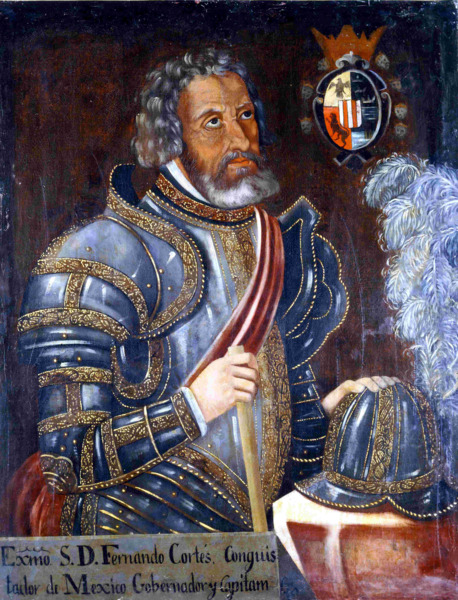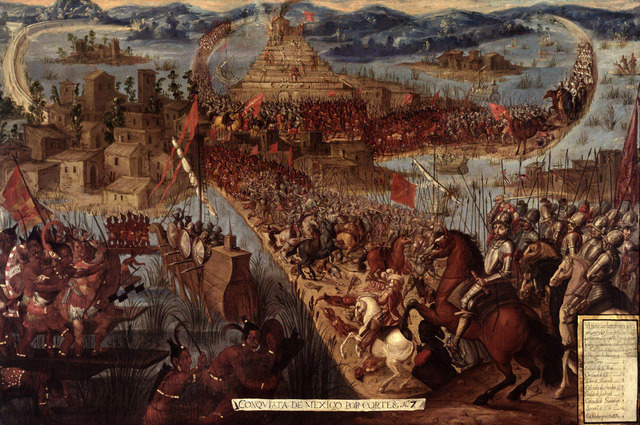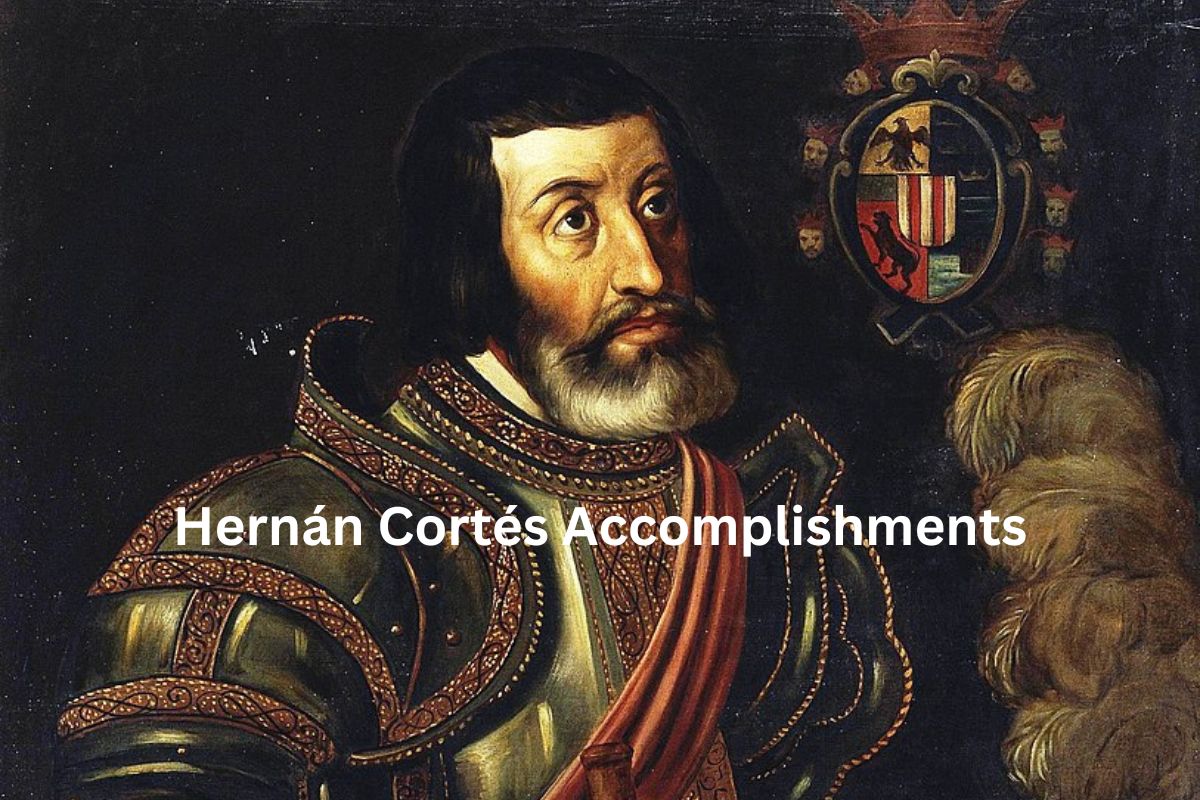Hernan Cortes was a Spanish conquistador born in 1485 in Medellin, Spain. In 1519, he led an expedition to the New World, setting sail for Mexico. Cortes is best known for his conquest of the Aztec Empire, which culminated in the fall of the Aztec capital, Tenochtitlan, in 1521.
He employed military tactics, forged alliances with indigenous groups, and captured the Aztec emperor, Moctezuma II. Cortes established Mexico City on the ruins of Tenochtitlan and served as the first governor and captain general of New Spain.
His expeditions also explored the Yucatan Peninsula and the western coast of Mexico, including Baja California. Cortes introduced Catholicism to the indigenous peoples and played a significant role in the expansion of Spanish influence in the Americas.
Despite his accomplishments, his actions resulted in the loss of indigenous lives, cultural destruction, and exploitation. Hernan Cortes died in 1547 in Seville, Spain, leaving a complex legacy in the history of the Spanish colonization of the Americas.
Accomplishments of Hernán Cortés
1. Conquest of the Aztec Empire
Hernan Cortes led an expedition to conquer the powerful Aztec Empire, ruled by Moctezuma II, in 1521. Cortes, with the help of indigenous allies dissatisfied with Aztec rule, such as the Tlaxcalans, launched a campaign that ultimately led to the fall of the Aztec capital, Tenochtitlan.
Also Read: Timeline of Hernan Cortes
Despite facing challenges and fierce resistance from the Aztecs, Cortes strategically employed military tactics, alliances, and the element of surprise to overcome the formidable empire.
The conquest of the Aztec Empire marked a turning point in the history of the Americas and significantly expanded Spanish influence in the region.

2. Capture of Moctezuma II
During the conquest of the Aztec Empire, Hernan Cortes managed to capture Moctezuma II, the Aztec emperor. This capture was a significant blow to Aztec morale and authority.
Moctezuma II was initially treated as a hostage by Cortes, hoping to use him to exert control over the Aztec population.
However, the situation turned volatile, and Moctezuma II died under mysterious circumstances. Nonetheless, the capture of the Aztec emperor weakened the empire’s leadership and played a crucial role in facilitating Cortes’ eventual victory.
3. Establishment of Mexico City
Following the conquest, Hernan Cortes founded the city of Mexico City on the ruins of the Aztec capital, Tenochtitlan. The new city served as the political, economic, and cultural center of Spanish presence in the region, eventually becoming the capital of New Spain.
Cortes played a significant role in the city’s planning and development, incorporating Spanish architectural styles and urban design. Mexico City became an important hub for Spanish colonial activities, trade, and governance in the Americas, shaping the course of history in the region.
4. Founding of Veracruz
Before the conquest of the Aztec Empire, Hernan Cortes established the city of Veracruz in 1519. He selected this location as a strategic port on the Gulf of Mexico, serving as a vital supply route and base of operations for his expedition.
Cortes named the city “Villa Rica de la Vera Cruz,” meaning “Rich Village of the True Cross.” Veracruz became an essential center for Spanish presence in the region, facilitating communication, trade, and the arrival of reinforcements and supplies.

5. Exploration of the Yucatan Peninsula
In addition to his conquest of the Aztec Empire, Hernan Cortes led expeditions to explore and establish Spanish presence in the Yucatan Peninsula. In 1519, he sent an expedition under the command of Pedro de Alvarado to explore the region.
The expeditions allowed Cortes to gather information, establish alliances with local indigenous groups, and expand Spanish territorial claims. These explorations laid the foundation for future Spanish colonization efforts in the Yucatan Peninsula.
6. Suppression of the Aztec Rebellion
Following the initial conquest of the Aztec Empire, Hernan Cortes faced a significant Aztec rebellion known as the “Noche Triste” or “Sad Night” in 1520. The rebellion erupted after Cortes left Tenochtitlan to deal with a Spanish expedition sent to arrest him.
During his absence, the Aztecs revolted against the Spanish presence in the city. The rebellion resulted in the death of many Spanish soldiers and their indigenous allies, forcing Cortes and his remaining forces to retreat from Tenochtitlan.
Despite this setback, Cortes regrouped, formed alliances with indigenous groups hostile to the Aztecs, and launched a counteroffensive. In 1521, after months of intense fighting and besieging the city, Cortes successfully suppressed the rebellion and recaptured Tenochtitlan.
The victory marked the final phase of the conquest of the Aztec Empire, solidifying Spanish control over the region. Cortes’ ability to regroup, adapt his strategies, and overcome adversity demonstrated his military leadership and determination to achieve his objectives.
7. Discovery of Baja California
In 1535, Hernan Cortes organized an expedition to explore the western coast of Mexico and the Gulf of California. During this expedition, Cortes and his men sailed along the peninsula, now known as Baja California.
They made significant discoveries, mapping the coastline and encountering various indigenous groups along the way. Cortes’ exploration contributed to the European understanding of the geography of the region and expanded Spanish knowledge of the Pacific coast.
8. Governance and Administration of New Spain
After the conquest of the Aztec Empire, Hernan Cortes was appointed as the first governor and captain general of New Spain. This position granted him the authority to govern and administer the newly conquered territories on behalf of the Spanish crown.
Cortes established a system of governance, implemented laws and regulations, and oversaw the establishment of Spanish settlements throughout the region. His leadership played a crucial role in consolidating Spanish control and establishing the foundations of colonial rule in New Spain.
9. Introduction of Christianity to the Americas
Hernan Cortes and his expedition brought Catholicism to the indigenous populations of the Americas. Along with the Spanish conquest, the Catholic Church played a central role in the colonization process.
Cortes actively promoted the conversion of indigenous peoples to Christianity, establishing churches, promoting religious practices, and often forcibly imposing the new faith. The introduction of Christianity had a profound and lasting impact on the religious and cultural landscape of the Americas.
10. Influence on Spanish Colonial Expansion
Hernan Cortes’ conquest of the Aztec Empire had a significant influence on the course of Spanish colonial expansion in the Americas. The success of his expedition inspired subsequent Spanish conquistadors and explorers to undertake similar endeavors.
Cortes’ strategies, military tactics, and methods for dealing with indigenous populations became a model for future Spanish expeditions. His conquest demonstrated the potential for immense wealth and power through the colonization of the Americas, contributing to Spain’s motivation to further expand its empire in the New World.
Cortes’ accomplishments laid the groundwork for Spain’s dominance in the region and shaped the history of Spanish colonization in the Americas.
